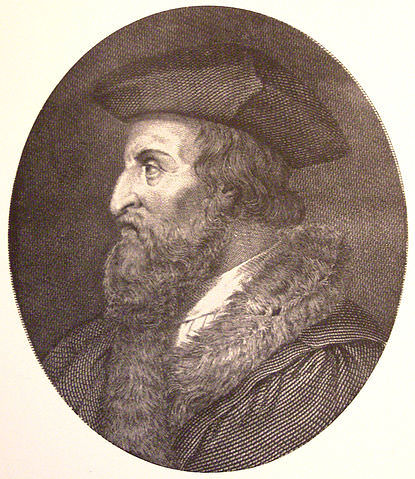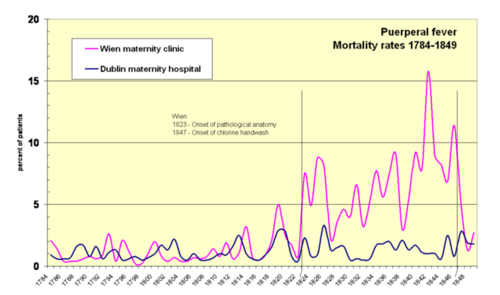1.4 科学理论论
章节大纲
-
Oh Vapor So Foul!
::蒸汽苏富尔!The man in this sketch is holding his nose to avoid in miasma. Miasma refers to a toxic vapor that people believed for centuries was a cause of many diseases, including cholera and plague. The idea that miasma caused disease was first proposed in the second century B.C.E. by a prominent Greek physician named Galen. He believed that miasma — which is identifiable by its foul smell — emanated from rotting organic matter and sickened people who lived close enough to inhale it. Miasma was the predominant explanation for disease transmission from the time of Galen until the germ theory of disease became widely accepted in the late 1800s.
::米亚斯马(Miasma)提到人们认为几个世纪以来就已是许多疾病,包括霍乱和瘟疫的起因的有毒蒸气,米亚斯马引起的疾病是公元前二世纪希腊著名医生加伦首次提出的想法,他认为米亚斯马(以其臭味为特征)起源于腐烂的有机物和住得够近、足以吸入它的人,米亚斯马是从加伦时代到1800年代后期疾病细菌理论被广泛接受的主要原因。What Is a Scientific Theory?
::什么是科学理论?Germ theory, which is described in detail below, is one of several scientific theories you will read about in human biology . A scientific theory is a broad explanation for events. Scientific theories are widely accepted by the scientific community. To become a theory , an explanation must be strongly supported by a great deal of evidence .
::下文详述的Germ理论,是人类生物学中你将读到的若干科学理论之一。科学理论是事件的广泛解释。科学理论被科学界广泛接受。 科学理论要成为理论,解释必须获得大量证据的有力支持。People commonly use the word theory to describe a guess or hunch about how or why something happens. For example, you might say, "I think a woodchuck dug this hole in the ground, but it's just a theory." Using the word theory in this way is different from the way it is used in science . A scientific theory is not just a guess or hunch that may or may not be true. In science, a theory is an explanation that has a high likelihood of being correct because it is so well supported by evidence.
::人们通常用这个理论来描述一个猜测或预感 如何或为什么发生一些事情。例如,你可能会说,“我认为木匠在地上挖了这个洞,但这只是个理论。”这样使用这个词的理论与在科学上使用它的方式不同。科学理论不仅仅是一个猜测或预感,也可能不是真实的。在科学上,一个理论是一种解释,很有可能是正确的,因为它有证据的很好支持。Germ Theory: A Human Biology Example
::热理论:人类生物学实例The germ theory of disease states that contagious diseases are caused by germs, or microorganisms, which are organis ms that are too small to be seen without magnification. Microorganisms that cause disease are called . Human pathogens include and , among other microscopic entities. When pathogens invade humans or other living hosts, they grow, reproduce, and make their hosts sick. Diseases caused by germs are contagious because the microorganisms that cause them can spread from person to person.
::疾病细菌理论指出,传染性疾病是由细菌或微生物引起的,这些微生物太小,无法在不放大的情况下看到; 造成疾病的微生物被称为:人类病原体包括并且除其他微生物体外还包括:当病原体侵入人类或其他生物宿主时,它们会生长、繁殖和使其宿主生病; 细菌引起的疾病具有传染性,因为导致这些病原体的微生物会从人到人传播。First Statement of Germ Theory
::格姆理论的第一次陈述Germ theory was first clearly stated by an Italian physician named Girolamo Fracastoro (pictured ) in the mid-1500s. Fracastoro proposed that contagious diseases are caused by transferable "seed-like entities," which we now call germs. According to Fracastoro, germs spread through through direct or indirect contact between individuals, making people sick.
::赫尔姆理论最初由意大利医生弗拉卡托罗(Girolamo Frascatoro)(Picture ) 于1500年代中期首次明确指出。 弗拉卡托罗建议传染性疾病是由可转移的“类似种子的实体 ” , 我们现在称之为细菌。 根据弗拉卡索罗(Fracasoro)的说法,细菌通过个人之间的直接或间接接触传播,导致人们生病。Girolamo Fracastoro made the first clear statement of the germ theory of disease.
::Girolamo Frascadoro首次明确阐述了疾病细菌理论。Fracastoro's idea, though essentially correct, was disregarded by other physicians. Instead, Galen's idea of miasma remained the accepted explanation for the spread of disease for another 300 years. However, evidence for Fracastoro's idea accumulated during that time. Some of the earliest evidence was provided by the Dutch lens and maker Anton van Leeuwenhoek, who is considered by many to be the father of microbiology . By the 1670s, van Leeuwenhoek had directly observed many different types of microorganisms, including bacteria.
::弗拉卡斯特罗的想法虽然基本正确,但却被其他医生所忽视。相反,加伦对米亚斯马的想法仍然是对疾病再传播300年的公认解释。然而,弗拉卡斯特罗的想法在那个时候积累了证据。一些最早的证据是由荷兰的镜头和制造人Anton van Leeuwenhoek提供的,后者被许多人视为微生物学之父。到1670年代,范利乌文豪克直接观察到许多不同类型的微生物,包括细菌。Evidence from Puerperal Fever
::普珀尔火烧场的证据One of the first physicians to demonstrate that a microorganism is the cause of a specific human disease was the Hungarian obstetrician Ignaz Semmelweis in the 1840s. The disease was puerperal fever, an often-fatal infection of the female reproductive organs . Puerperal fever is also called childbed fever, because it usually affects women who have just given birth.
::1840年代匈牙利产科医生Ignaz Semmelweis是最早证明微生物是特定人类疾病原因的医生之一,该疾病是产后发烧,往往是女性生殖器官的致命感染,围产期发烧也被称为儿童发烧,因为它通常影响刚分娩的妇女。Semmelweis observed that deaths from puerperal fever occurred much more often when women had been attended by doctors at his hospital than by midwives at home. Semmelweis also noticed that doctors often came directly from autopsies to the beds of women about to give birth. From his observations , Semmelweis inferred that puerperal fever was a contagious disease caused by some type of matter carried to pregnant patients on the hands of doctors from autopsied bodies. As a consequence, Semmelweis urged doctors and medical students at his hospital to wash their hands with chlorinated lime before examining pregnant women. After this change, the hospital's death rate for women who had just given birth fell from 18 to 2 percent, which was a 90 percent reduction. Some of Semmelweis' findings are presented in the graph .
::Semmelweis认为,产后发烧是一种传染病,由某种物质携带给尸体解剖医生的孕妇。因此,Semmelweis敦促医院的医生和医科学生在检查孕妇之前用氯化石灰洗手。经过这一改变,刚分娩的妇女的医院死亡率从18%下降到2%,下降了90%。Semmelweis showed how deaths from puerperal fever increased after doctors began doing autopsies at Wien Maternity Clinic (first vertical line) and decreased after doctors started disinfecting their hands (second vertical line). For comparison, he showed the lower death rates at Dublin Maternity Hospital, where autopsies were not performed.
::Semmelweis展示了在Wien妇产诊所(第一垂直线)医生开始进行尸检(第一垂直线 ) , 以及医生开始对手进行消毒(第二垂直线 ) , 产后发烧导致的死亡率如何上升。 相比之下,他展示了都柏林妇产医院(那里没有进行尸检 ) , 死亡率较低。Semmelweis published his results, but they were derided by the medical profession. The idea that doctors themselves were the carriers of a fatal disease was taken as a personal affront by his fellow physicians. One of Semmelweis' peers protested indignantly that doctors are gentlemen and that gentlemen's hands are always clean. As a result of attitudes such as this, Semmelweis became the target of a vicious smear campaign. Eventually, Semmelweis had a mental breakdown and was committed to a mental hospital, where he died.
::Semmelweis发表了他的研究结果,但是他们被医学界嘲笑。医生本身是致命疾病的携带者这一想法被他的医生伙伴视为个人的侮辱。Semmelweis的一位同龄人愤怒地抗议医生是绅士,而男士的手总是干净的。由于这种态度,Semmelweis成了恶意诽谤运动的目标。最后,Semmelweis精神崩溃,被送往精神病院,死在那里。Father of Germ Theory
::格姆理论之父Throughout the later 1800s, more formal investigations were conducted about the relationship between germs and disease. Some of the most important were undertaken by Louis Pasteur (pictured in his lab ). Pasteur was a French chemist who did careful to show that , food spoilage, and certain diseases are caused by microorganisms. He discovered the cause of puerperal fever in 1879. He determined it was an infection caused by the bacterium Streptococcus pyogenes, shown under magnification .
::在整个1800年代后期,对细菌和疾病之间的关系进行了更正式的调查,其中最重要的调查由Louis Pasteur(在他的实验室中拍摄)进行,Pasteur是一名法国化学家,他小心谨慎地表明食物的变质和某些疾病是由微生物造成的,他于1879年发现了产后发烧的原因,他确定这是由细菌Streptococcccus pyogenes引起的感染,在放大法下显示。Louis Pasteur investigated the causes of diseases, such as puerperal fever.
::Louis Pasteur调查了产后发烧等疾病的原因。Pasteur discovered that the bacterium Streptococcus pyogenes causes puerperal fever.
::巴斯德发现 细胞链球菌类植物 导致产后发烧Although Pasteur was not the first person to propose germ theory, his investigations clearly supported it. He also became a strong proponent of the theory and managed to convince most of the scientific community of its validity. For these reasons, Pasteur is often regarded as the father of germ theory.
::尽管巴斯德不是第一个提出细菌理论的人,但他的调查显然支持这一理论,他也成为该理论的坚定支持者,并设法说服大多数科学界相信这一理论的有效性。 出于这些原因,巴斯德常常被视为细菌理论之父。Summary
::摘要-
A scientific theory is a broad explanation that is widely accepted because it is strongly supported by a great deal of evidence.
::科学理论是一个广泛解释,得到广泛接受,因为它得到大量证据的有力支持。 -
An example of a scientific theory is the germ theory of disease. According to this theory, contagious diseases are caused by germs, or microorganisms.
::科学理论的一个例子是疾病的细菌理论。 根据这一理论,传染病是由细菌或微生物引起的。 -
The germ theory of disease was first proposed in the mid-1500s. It was not widely accepted until the late 1800s, when it was strongly supported by experimental evidence from Louis Pasteur.
::疾病细菌理论最初是在1500年代中期提出的,直到1800年代末才被广泛接受,当时路易斯·巴斯德的实验证据有力地支持这一理论。
Review
::回顾1. Define scientific theory.
::1. 界定科学理论。2. Compare the way the word theory is used in science versus in everyday language.
::2. 比较在科学中和在日常语言中使用理论的方式。3. What is the germ theory of disease? How did it develop?
::3. 疾病细菌理论是什么?它是如何发展的?4. Explain why Pasteur, rather than Fracastoro or Semmelweis, is called the father of germ theory.
::4. 解释为什么巴斯德而不是弗拉卡斯特罗或森梅尔韦斯被称为细菌理论之父。5. Galen and Fracastoro may have come up with different explanations for how disease is spread, but what observations do you think they made that were similar?
::5. Galen和Frascadoro也许对疾病是如何传播提出了不同的解释,但你们认为他们提出的类似看法是什么?6. Use the explanation of Semmelweis’ research and the graph above to answer the following questions.
::6. 使用Semmelweis研究的解释和上图回答下列问题。a. What was Semmelweis’ observation that led him to undertake this study? What question was he trying to answer?
::a. Semmelweis的意见是什么使他进行了这项研究?他想回答什么问题?b. What was the hypothesis (i.e. proposed answer for a scientific question) that Semmelweis was testing?
::b. Semmelweis是测试的假设(即对科学问题的拟议答复)是什么?c. Why did Semmelweis track death rates from puerperal fever at Dublin Maternity Hospital, where autopsies were not performed?
::c. 为什么Semmelweis跟踪都柏林妇产医院的产后热死亡率,那里没有进行尸体解剖?d. What were two pieces of evidence shown in the graph that supported Semmelweis’ hypothesis?
::d. 图表中支持Semmelweis假设的两个证据是什么?e. Why do you think it was important that Semmelweis compared Dublin Maternity Hospital and Wien Maternity Clinic over the same years?
::e. 为什么你认为Semmelweis与都柏林妇产医院和Wien妇产诊所同年比较很重要?7. What is the difference between a microorganism and a pathogen?
::7. 微生物和病原体有什么区别?8. Explain why the development of the microscope lent support to the germ theory of disease.
::8. 解释为什么显微镜的发展为疾病细菌理论提供了支持。9. Does the observation of microorganisms alone conclusively prove that germ theory is correct? Why or why not?
::9. 仅仅对微生物的观察是否就确凿地证明细菌理论是正确的?为什么或为什么不是?10. Who do you think was using more scientific reasoning: Semmelweis or the physicians that derided his results? Explain your answer.
::10. 你认为谁在使用更科学的推理:Semmelweis或嘲笑其结果的医生?解释你的答复。Explore More
::探索更多Watch this short video for a dramatization of Semmelweis' work on puerperal fever and its negative reception by other physicians at the time.
::观看这段短片, 让Semmelweis关于产后发烧的作品戏剧化, 并受到其他医生的负面反应。How does a scientific theory differ from a scientific law? Watch this TED animation to find out.
::科学理论与科学法有何不同?看TED的动画来了解。 -
A scientific theory is a broad explanation that is widely accepted because it is strongly supported by a great deal of evidence.




